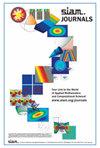多照度成像模式分辨率分析的算子理论
IF 2.3
3区 数学
Q3 COMPUTER SCIENCE, ARTIFICIAL INTELLIGENCE
引用次数: 1
摘要
SIAM影像科学杂志,第16卷,第4期,2105-2143页,2023年12月。摘要。通过引入新的算子理论,为多照度成像问题中一般光源分辨率提供了统一的数学理论。我们的主要思想是将多照度成像转化为单快照成像,并采用一种新的成像核,该核既依赖于照度模式,又依赖于成像系统的点扩展函数。因此,我们证明了多照度成像的分辨率近似由新成像核的基本截止频率决定,而新成像核的基本截止频率大致受点扩展函数的截止频率与照度模式中最大基本频率之和的限制。我们的理论提供了一种统一的方法来估计现有的各种超分辨率模态的分辨率,并得到了与实验结果相同的估计。此外,基于多照度成像问题的重新表述,我们还估计了基于稀疏性的方法解决复杂光源和正光源的分辨率极限。结果表明,基于算子理论的多照度成像分辨率近似由新的成像核决定,而在实际应用中,稀疏度提升技术可以实现更高的分辨率,但仅适用于非常稀疏的光源。这解释了实验中观察到的一些基于稀疏度的超分辨率模式的现象。本文章由计算机程序翻译,如有差异,请以英文原文为准。
An Operator Theory for Analyzing the Resolution of Multi-illumination Imaging Modalities
SIAM Journal on Imaging Sciences, Volume 16, Issue 4, Page 2105-2143, December 2023.
Abstract. By introducing a new operator theory, we provide a unified mathematical theory for general source resolution in the multi-illumination imaging problem. Our main idea is to transform multi-illumination imaging into single-snapshot imaging with a new imaging kernel that depends on both the illumination patterns and the point spread function of the imaging system. We therefore prove that the resolution of multi-illumination imaging is approximately determined by the essential cutoff frequency of the new imaging kernel, which is roughly limited by the sum of the cutoff frequency of the point spread function and the maximum essential frequency in the illumination patterns. Our theory provides a unified way to estimate the resolution of various existing super-resolution modalities and results in the same estimates as those obtained in experiments. In addition, based on the reformulation of the multi-illumination imaging problem, we also estimate the resolution limits for resolving both complex and positive sources by sparsity-based approaches. We show that the resolution of multi-illumination imaging is approximately determined by the new imaging kernel from our operator theory and better resolution can be realized by sparsity-promoting techniques in practice but only for resolving very sparse sources. This explains experimentally observed phenomena in some sparsity-based super-resolution modalities.
Abstract. By introducing a new operator theory, we provide a unified mathematical theory for general source resolution in the multi-illumination imaging problem. Our main idea is to transform multi-illumination imaging into single-snapshot imaging with a new imaging kernel that depends on both the illumination patterns and the point spread function of the imaging system. We therefore prove that the resolution of multi-illumination imaging is approximately determined by the essential cutoff frequency of the new imaging kernel, which is roughly limited by the sum of the cutoff frequency of the point spread function and the maximum essential frequency in the illumination patterns. Our theory provides a unified way to estimate the resolution of various existing super-resolution modalities and results in the same estimates as those obtained in experiments. In addition, based on the reformulation of the multi-illumination imaging problem, we also estimate the resolution limits for resolving both complex and positive sources by sparsity-based approaches. We show that the resolution of multi-illumination imaging is approximately determined by the new imaging kernel from our operator theory and better resolution can be realized by sparsity-promoting techniques in practice but only for resolving very sparse sources. This explains experimentally observed phenomena in some sparsity-based super-resolution modalities.
求助全文
通过发布文献求助,成功后即可免费获取论文全文。
去求助
来源期刊

SIAM Journal on Imaging Sciences
COMPUTER SCIENCE, ARTIFICIAL INTELLIGENCE-COMPUTER SCIENCE, SOFTWARE ENGINEERING
CiteScore
3.80
自引率
4.80%
发文量
58
审稿时长
>12 weeks
期刊介绍:
SIAM Journal on Imaging Sciences (SIIMS) covers all areas of imaging sciences, broadly interpreted. It includes image formation, image processing, image analysis, image interpretation and understanding, imaging-related machine learning, and inverse problems in imaging; leading to applications to diverse areas in science, medicine, engineering, and other fields. The journal’s scope is meant to be broad enough to include areas now organized under the terms image processing, image analysis, computer graphics, computer vision, visual machine learning, and visualization. Formal approaches, at the level of mathematics and/or computations, as well as state-of-the-art practical results, are expected from manuscripts published in SIIMS. SIIMS is mathematically and computationally based, and offers a unique forum to highlight the commonality of methodology, models, and algorithms among diverse application areas of imaging sciences. SIIMS provides a broad authoritative source for fundamental results in imaging sciences, with a unique combination of mathematics and applications.
SIIMS covers a broad range of areas, including but not limited to image formation, image processing, image analysis, computer graphics, computer vision, visualization, image understanding, pattern analysis, machine intelligence, remote sensing, geoscience, signal processing, medical and biomedical imaging, and seismic imaging. The fundamental mathematical theories addressing imaging problems covered by SIIMS include, but are not limited to, harmonic analysis, partial differential equations, differential geometry, numerical analysis, information theory, learning, optimization, statistics, and probability. Research papers that innovate both in the fundamentals and in the applications are especially welcome. SIIMS focuses on conceptually new ideas, methods, and fundamentals as applied to all aspects of imaging sciences.
 求助内容:
求助内容: 应助结果提醒方式:
应助结果提醒方式:


